
Wine Culture and Information since 2002 - Volume 22
 Wine Culture and Information since 2002 - Volume 22 |
|
Issue 144, October 2015 |
Contents |
|
|
Harvesting 2015: the Wine to Be |
|
Here we are again. The fundamental moment of the year every vintner is waiting has come again, the most important event for wine making and that determines, for most of the part, the fate of a year of work. Harvesting represents in fact the fundamental test both of the benevolence or anger of Mother Nature, as well as of the work of the vintner. It should in fact be said, whoever cultivates a vineyard or makes wine, always have a watchful eye to the sky and to vines. The intent is to understand and, frequently prevent, what Nature gives in the course of the season, for better or worse. By considering the course of 2015, benevolence has been quite generous of sun and sultriness; rains and water scarcely given, with a subsequent water deprivation for vines. It should be said, as a matter of fact, in the past weeks, in some areas of Italy, has rained quite a lot, even hailstorms, endangering part of the harvesting. In general terms, and while avoiding the ridiculous and speculative definition of harvesting of the century - I prefer to simply call it harvesting 2015 - vineyards of Italy gave excellent grapes. It sounds like the right reward for what happened in 2014, a vintage many will remember for the frequent and abundant rains. The past vintage has been quite hard for vintners, forced to take proper actions to the best they could, while trying to “save what they could”. They are different and extreme conditions, none of them can be defined as balanced. It should also be said too much heat and sun, despite this helps the ripening of grapes, endangers the vine by depriving it from precious water. It is also true that, in general terms, the lack of water forces the vine to dig the soil and search for the vital liquid, therefore developing longer roots. Provided there is water underground and, for this, we need rains in the right quantity. Professional associations about wine and vine cultivation have already released their opinions about vintage 2015 and, in their anticipations, there are - or better to say, there should be, as many vintners are still harvesting their grapes - few regions in Italy to have a reason to complain about. Everyone agrees on quantities, by saying there could be an increase in production of about 13% in terms of wine. It should be said that, of course, this does not mean a quality wine production, a factor going beyond the simple numbers of what has been harvested in vineyards. However, the quality of grapes seems to be good in every region of Italy, therefore, on this regard, it seems we had a good start. Of course, from harvesting to glass many things may happen and, sometimes, the good hopes of the vineyard are not confirmed by the glass. It is also true the opposite: we all remember about vintage 2002 - unanimously defined in Italy as “terrible” - nevertheless, after many years, some wines of that vintage are today stellar. The expected figures say 40% of the grapes harvested in 2015 will be destined to Denominazione d'Origine Controllata and Denominazione d'Origine Controllata e Garantita wines, the rest equally divided in Indicazione Geografica Tipica and table wines. Coldiretti - the Italian association of farmers - says the expected production of wine for 2015 will be of forty-seven millions hectoliters, a quantity that - for those interested in the fundamental, passionate and eternal challenge Italy versus France - will allow Italy to overtake France for a little more than half a million of hectoliters. This will happen, of course, depending on Mother Nature's will, in particular without excessive rains and adverse weather conditions that could change these figures. However, this is something already happened in certain areas of Italy, as September rains have caused damages to vineyards and a subsequent loss of part of grapes. Despite of this, many believe vintage 2015 will be of high quality, even with remarkable excellent results. As far as I am concerned, it will be the glass - as usual - to tell whether these expectations turned into reality or not. However, by evaluating the expected figures of past weeks, as for quantity, it will be Veneto to win the highest ranking of the podium with its 9.1 millions of hectoliters of wine. On the other hand, Tuscany records a decrease of 5% in regard to 2014, caused by - unfortunately - the adverse weather conditions happened in the beginning of September. Lombardy and Sardinia confirm the production of 2014, whereas Apulia increases its production of wine for 25%. Increments in productions are also recorded in other regions: Campania +20%; Trentino Alto Adige +15%; Friuli Venezia Giulia, Veneto, Pidemont, Marches and Sicily +10%; Emilia Romagna +5%. Riccardo Cotarella, president of Italian wine makers association, said - realistically - in some areas of Italy will be produced wines of high quality whereas mediocre ones in others, by also saying it will be a good vintage for whites, too early to say something about reds. The exceptional heat of summer 2015, has strongly favored the ripening of grapes, virtually forcing to harvest grapes in advance all over Italy. Something that, in certain areas, has been quite significant. It should be said that, if it is true harvesting of white grapes is virtually completed all over Italy, the same cannot be said for red grapes. In fact, some varieties will be even harvested in November, therefore it is quite hard to say something as well as being incautious because of any possible weather condition. The only thing we can do with absolute certainty, is the best wish to all women and men who, even this year, will be involved in vineyards and in wine making. To all of them, with no exception, the best wishes because their hard work of the year will be rewarded with great wines or, to say the least, the very best possible. Our best wishes to you all: we are with you. Antonello Biancalana
|
||||
Contrasts of Verdicchio and Müller ThurgauTwo different grapes however both capable of expressing wines with opposed characters, yet elegant, having a quite unique personality |
|
The former is a great white grape indigenous to Marches, the latter was born in Germany, result of a successful crossing, it then travels to Switzerland and then to Italy. Wines produced with Verdicchio - the white berried grape queen of vineyards in Marches - have been defined by many as “reds dressed in white”. A definition that, to tell the truth, is also used for other white wines, usually for those that - when they are tasted - express a pretty robust structure. Müller Thurgau has a quite different character, having in the freshness of aromas its primary personality and, in terms of structure, its wines have a quite weaker body. Even Verdicchio, of course, gives wines expressing pleasing olfactory sensations, however the character of the two wines is quite distant one from each other, however characterized by their own elegance. These two varieties are generally used alone for the production of wines, rarely blended to other grapes. This characteristic, common to Verdicchio and Müller Thurgau, allows these two grapes to express a remarkable wine making versatility, from dry whites to sweet wines produced with dried grapes, including sparkling wines, both Charmat and Classic Method. The spreading of the two grapes, because of the characteristic of being rarely used blended to other grapes, is pretty limited. Whether Müller Thurgau is found in some regions of Italy - as well as in other areas of the world - Verdicchio is virtually found in Marches only. The rare cases in which we find Verdicchio outside the borders of its original region, it is always blended to other grapes, however, it is never the dominant grape. Two grapes, very different one from each other, certainly suited for a comparative tasting by contrast. Verdicchio is the main white berried grape of Marches and this region is its homeland. Verdicchio has a strong connection with Marches and, wines produced with this grape in other regions, do not express the same character and personality. The origin of Verdicchio is not clear, however it is believed to be an indigenous variety of Marches and the grape - as a matter of fact - does not have any genetic analogy with other grapes. The first written documents which could be associated to Verdicchio are dated back to the middle times. It is about notary deeds in which are described vineyards which could refer to the famous white berried grape of Marches. It is only in the half of the 1500s we can find the first written mention of Verdicchio in a document. Grape always used for the production of wine, it will be only at the end of 1700s they will finally understand its huge wine making potentials, therefore becoming - with no doubt - among the most important grapes of Marches and then of Italy. Castelli di Jesi and Matelica are the main areas for the production of Verdicchio, of which Cupramontana is the most significant and famous place. Verdicchio gets its name from the characteristic color of its berries - Verdicchio in Italian means something having greenish nuances - with evident green hues and that, frequently, are also found in its wines. Verdicchio is marginally spread in Abruzzo, Umbria and Latium, however in none of these regions is capable of expressing interesting results. Verdicchio is famous for its wines having a good structure and a vibrant crispness. Grape of remarkable versatility, Verdicchio proves its wine making value also in the production of sparkling wines, both using the Charmat and Classic Method with the refermentation in bottle. By properly allowing the withering of grapes, it gives sweet wines of excellent elegance, characterized by a good structure and crispness, a fundamental characteristic for the balance in this style of wines. The history of Müller Thurgau is more clear as it is a crossing created at the end of 1800s, in that time in which many attempts were made in order to improve grapes by means of crossing and hybridization. In 1882 Prof. Hermann Müller - at those time working at the Geisenheim Grape Breeding Institute, Germany - was trying to combine the finesse and intensity of Riesling to the ability to ripen earlier of Sylvaner. The resulting crossing did not have the characteristics he wanted, however it quickly became successful in Germany. Prof. Müller decider to call the new crossing Müller Thurgau, by adding to his family name Thurgau (Thurgovia), the Swiss canton where he was born in. For many decades this grape was considered to be the crossing of Riesling with Sylvaner, however recent genetic researches allowed to understand Müller Thurgau is a crossing of Riesling with Madeleine Royale.
This variety is still today quite spread in many areas of Europe and it is also found in Australia, New Zealand and United States of America. Müller Thurgau is also cultivated in Italy, in particular in Trentino Alto Adige region where it is capable of making interesting and characteristic wines, especially in the Val di Cembra area. In Italy this variety is also cultivated in Sicily for the production of table and sparkling wines. Müller Thurgau makes wines characterized by aromas which could recall aromatic varieties, while noticing this grape does not belong to this category. This characteristic makes Müller Thurgau suited to the production of Charmat sparkling wines, capable of enhancing the aromatic profile of the grape. Wines of a light body, of immediate and pleasing crispness, it is preferred to vinify this grape in inert containers in order to favor the typical characteristics of Müller Thurgau and its aromas. Our comparative tasting by contrast will evaluate a Verdicchio dei Castelli di Jesi and a Müller Thurgau from Trentino Alto Adige, both belonging to the same vintage. We will choose two young wines, therefore of the current vintage, while making sure they have been vinified in inert containers, preferably in steel tanks. On this regard it should be noticed that if it is true Müller Thurgau is virtually vinified in steel tanks only, in certain cases Verdicchio is fermented and aged in cask, even barrique. The two wines will be served in two distinct tasting glasses at a temperature of 10 °C (50 °F). This temperature will in fact allow the best appreciation of crispness in both wines while ensuring the right perception of typical aromatic qualities of Verdicchio and Müller Thurgau. We will start our comparative tasting by contrast by observing the two wines in the glass. Two wines being very different in their appearance, in which can be recognized - like to say - the climate of the respective lands of production. Let's start by observing the glass of Müller Thurgau in which will be perceived a brilliant greenish yellow color and a high transparency. Nuances, observed to the edge of wine by tilting the glass and towards the opening, will show the same color. Colors characterizing Verdicchio dei Castelli di Jesi are more intense and bright than Müller Thurgau. The color of this famous white wine from Marches expresses an intense straw yellow color, in which can be frequently seen nuances of greenish yellow that - among the other things - is what gives the name to this grape. Let's tilt the glass and observe nuances, at the edge of the wine towards the opening. Also in this case we will see a straw yellow color with evident nuances of greenish yellow. The evaluation of aromas of Müller Thurgau and Verdicchio offers two olfactory profiles very different one from each other. The famous crossing of Prof. Hermann Müller, because of its characteristic aromas of fruits and, sometimes, grape, can be confused with an aromatic variety, a category to which this grape does not belong to. The aromatic exuberance of Müller Thurgau gives its wines very pleasing aromas of fruits, most of the times of immediate perception to the nose and appreciated for this reason. Verdicchio has a quite different character, with strong aromas which can sometimes be of dried fruits as well. In the famous white berried grape of Marches we in fact find sensations directly recalling white fruits, as well as flowers and a pleasing sensation of almond which is an identifying character for this variety. Verdicchio has a remarkable longevity, something allowing an interesting development of aromas while keeping its frank and sharp character. The first wine of which we will evaluate aromas is Müller Thurgau. By holding the glass in vertical position and, without swirling, let's proceed with the first smell in order to appreciate the opening of wine. From the glass will be perceived intense aromas of peach, apple and pineapple, as well as the characteristic hint of grape recalling, in many ways, aromatic varieties. After having swirled the glass, the wine completes its olfactory profile with flowers and fruits, in particular hawthorn and broom, as well as pear, banana, apricot, elder and sage. Let's now pass to the glass of Verdicchio dei Castelli di Jesi. The opening of this wine offers to the nose of the taster aromas of apple, pear, hawthorn and the characteristic hint of almond. Let's now proceed with the swirling of the glass in order to favor the development of the other aromas and let's do a second smell. We will perceive aromas of plum, broom, peach, citrus fruits, chamomile, thyme and pineapple. Differences between the two wines becomes quite distant in the evaluation of taste. Let's take a sip of Müller Thurgau and evaluate its attack in the mouth. It will be perceived a pleasing crispness and, soon after, a sensation of pretty moderate structure, however balanced by alcohol. Correspondence to the nose is very good: it will be clearly perceived flavors of peach, pear and pineapple, sometimes supported by a touch of grape. The attack of Verdicchio dei Castelli di Jesi is characterized by a fuller body when compared to Müller Thurgau. Also in this wine the crispness of wine is a dominant quality, generally well balanced by alcohol that, in Verdicchio, it frequently is higher than 13%. The correspondence to the nose is very good and it can be clearly perceived apple, pear, plum and, the typical quality of Verdicchio, almond. Two wines, without doubt, that on this regard, are very different one from each other. The ending part of our tasting is about the final sensations produced by the wines after having swallowed them. The finish of Müller Thurgau expresses a good persistence, leaving in the mouth a pleasing sensation of crispness as well as flavors perceived during the attack. It will also be possible to continue perceiving the moderate structure of the wine. Also the finish of Verdicchio dei Castelli di Jesi is characterized by a good persistence and, also in this case, it will be perceived an evident crispness and a good body. It will also be perceived the typical flavors of this wine, as well as the characteristic quality of Verdicchio recalling the flavor of almond. The pleasing crispness of both wines make them particularly agreeable while inviting - like to say - to fill the glass again. Two wines and two grapes very different one from each other, expression of two distant characters however agreeable and of interesting sensorial value.
|
||||||||||||
Wines of the Month |
|
|
|
Score legend Prices are to be considered as indicative. Prices may vary according to the country or the shop where wines are bought |
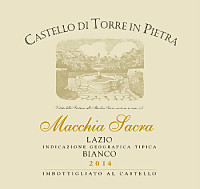
|
|
Macchia Sacra 2014 |
|
| Castello di Torre in Pietra (Latium, Italy) | |
 Fiano Fiano | |
| Price: € 7.00 | Score: |
 Brilliant ruby red and nuances of straw yellow, very transparent. Brilliant ruby red and nuances of straw yellow, very transparent. Intense, clean, pleasing and refined, starts with hints of plum,
hazelnut and honey followed by aromas of pear jam, hawthorn, ripe apple and
iodine. Intense, clean, pleasing and refined, starts with hints of plum,
hazelnut and honey followed by aromas of pear jam, hawthorn, ripe apple and
iodine.
 Crisp attack and however balanced by alcohol, good body, intense
flavors, pleasing roundness. Crisp attack and however balanced by alcohol, good body, intense
flavors, pleasing roundness.
 Persistent finish with flavors of plum, hazelnut and honey. Persistent finish with flavors of plum, hazelnut and honey. 2 months in cement tanks, 4 months in bottle. 2 months in cement tanks, 4 months in bottle. |
|
 Pasta with mushrooms, Roasted white meat, Roasted fish, Mushroom soups Pasta with mushrooms, Roasted white meat, Roasted fish, Mushroom soups |
|
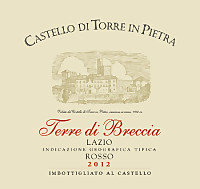
|
|
Terre di Breccia 2011 |
|
| Castello di Torre in Pietra (Latium, Italy) | |
 Montepulciano, Sangiovese, Cesanese Montepulciano, Sangiovese, Cesanese | |
| Price: € 6.75 | Score: |
 Intense ruby red and nuances of garnet red, little transparency. Intense ruby red and nuances of garnet red, little transparency. Intense, clean, pleasing and refined, starts with hints of black
cherry, plum and blueberry followed by aromas of violet, raspberry,
blackberry, tobacco, vanilla, carob and menthol. Intense, clean, pleasing and refined, starts with hints of black
cherry, plum and blueberry followed by aromas of violet, raspberry,
blackberry, tobacco, vanilla, carob and menthol.
 Properly tannic attack and however balanced by alcohol, good body,
intense flavors, pleasing roundness. Properly tannic attack and however balanced by alcohol, good body,
intense flavors, pleasing roundness.
 Persistent finish with flavors of plum, black cherry and blueberry. Persistent finish with flavors of plum, black cherry and blueberry. 9 months in cask, 9 months in bottle. 9 months in cask, 9 months in bottle. |
|
 Stuffed pasta with meat, Broiled meat and barbecue, Stewed meat, Roasted meat Stuffed pasta with meat, Broiled meat and barbecue, Stewed meat, Roasted meat |
|
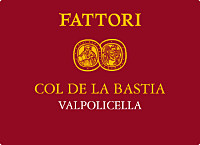
|
|
Valpolicella Col de la Bastia 2014 |
|
| Fattori (Veneto, Italy) | |
 Corvina (65%), Corvinone (15%), Rondinella (10%), Other Grapes (10%) Corvina (65%), Corvinone (15%), Rondinella (10%), Other Grapes (10%) | |
| Price: € 8.90 | Score: |
 Brilliant ruby red and nuances of ruby red, moderate transparency. Brilliant ruby red and nuances of ruby red, moderate transparency. Intense, clean, pleasing and refined, starts with hints of black
currant, black cherry and violet followed by aromas of blueberry, plum,
vanilla, cocoa and eucalyptus. Intense, clean, pleasing and refined, starts with hints of black
currant, black cherry and violet followed by aromas of blueberry, plum,
vanilla, cocoa and eucalyptus.
 Properly tannic attack and however balanced by alcohol, good body,
intense flavors, pleasing roundness. Properly tannic attack and however balanced by alcohol, good body,
intense flavors, pleasing roundness.
 Persistent finish with flavors of black currant, black cherry and plum. Persistent finish with flavors of black currant, black cherry and plum. Aged in steel tanks and cask. Aged in steel tanks and cask. |
|
 Stuffed pasta, Broiled meat and barbecue, Stewed meat Stuffed pasta, Broiled meat and barbecue, Stewed meat |
|
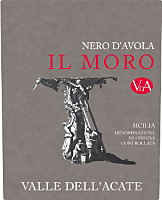
|
|
Il Moro 2012 |
|
| Valle dell'Acate (Sicily, Italy) | |
 Nero d'Avola Nero d'Avola | |
| Price: € 12.00 | Score: |
 Intense ruby red and nuances of ruby red, moderate transparency. Intense ruby red and nuances of ruby red, moderate transparency. Intense, clean, pleasing and refined, starts with hints of blackberry,
plum and violet followed by aromas of black cherry, raspberry, blueberry,
cinnamon, carob and vanilla. Intense, clean, pleasing and refined, starts with hints of blackberry,
plum and violet followed by aromas of black cherry, raspberry, blueberry,
cinnamon, carob and vanilla.
 Properly tannic attack and however balanced by alcohol, good body,
intense flavors, agreeable. Properly tannic attack and however balanced by alcohol, good body,
intense flavors, agreeable.
 Persistent finish with flavors of blackberry, plum and raspberry. Persistent finish with flavors of blackberry, plum and raspberry. 12 months in steel tanks, cask and bottle. 12 months in steel tanks, cask and bottle. |
|
 Broiled meat and barbecue, Sauteed meat with mushrooms, Stuffed pasta, Hard cheese Broiled meat and barbecue, Sauteed meat with mushrooms, Stuffed pasta, Hard cheese |
|
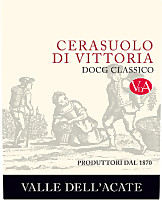
|
|
Cerasuolo di Vittoria Classico 2012 |
|
| Valle dell'Acate (Sicily, Italy) | |
 Nero d'Avola (60%), Frappato (40%) Nero d'Avola (60%), Frappato (40%) | |
| Price: € 12.50 | Score: |
 Brilliant ruby red and nuances of ruby red, moderate transparency. Brilliant ruby red and nuances of ruby red, moderate transparency. Intense, clean and pleasing, starts with hints of blackberry, plum and
black cherry followed by aromas of violet, raspberry, blueberry, carob,
tobacco and vanilla. Intense, clean and pleasing, starts with hints of blackberry, plum and
black cherry followed by aromas of violet, raspberry, blueberry, carob,
tobacco and vanilla.
 Properly tannic attack and however balanced by alcohol, good body,
intense flavors, pleasing crispness. Properly tannic attack and however balanced by alcohol, good body,
intense flavors, pleasing crispness.
 Persistent finish with flavors of blackberry, plum and raspberry. Persistent finish with flavors of blackberry, plum and raspberry. 12 months in cask, 9 months in bottle. 12 months in cask, 9 months in bottle. |
|
 Roasted meat, Stuffed pasta with meat, Stewed meat with mushrooms Roasted meat, Stuffed pasta with meat, Stewed meat with mushrooms |
|
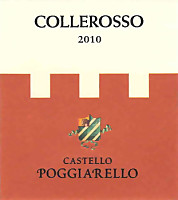
|
|
Collerosso 2010 |
|
| Castello Poggiarello (Tuscany, Italy) | |
 Cabernet Franc (50%), Merlot (50%) Cabernet Franc (50%), Merlot (50%) | |
| Price: € 20.00 | Score: |
 Intense ruby red and nuances of garnet red, little transparency. Intense ruby red and nuances of garnet red, little transparency. Intense, clean, pleasing, refined and elegant, starts with hints of
black currant, plum and black cherry followed by aromas of blueberry,
violet, iris, vanilla, chocolate, tobacco, mace and eucalyptus. Intense, clean, pleasing, refined and elegant, starts with hints of
black currant, plum and black cherry followed by aromas of blueberry,
violet, iris, vanilla, chocolate, tobacco, mace and eucalyptus.
 Properly tannic attack and however balanced by alcohol, good body,
intense flavors, pleasing roundness. Properly tannic attack and however balanced by alcohol, good body,
intense flavors, pleasing roundness.
 Persistent finish with flavors of black currant, black cherry and plum. Persistent finish with flavors of black currant, black cherry and plum. Aged in barrique. Aged in barrique. |
|
 Roasted meat, Broiled meat and barbecue, Stewed and braised meat, Hard cheese Roasted meat, Broiled meat and barbecue, Stewed and braised meat, Hard cheese |
|
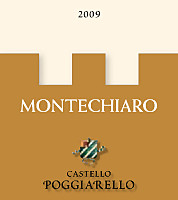
|
|
Montechiaro 2009 |
|
| Castello Poggiarello (Tuscany, Italy) | |
 Cabernet Franc Cabernet Franc | |
| Price: € 30.00 | Score: |
 Brilliant ruby red and nuances of garnet red, little transparency. Brilliant ruby red and nuances of garnet red, little transparency. Intense, clean, pleasing, refined and elegant, starts with hints of
black currant, black cherry and plum followed by aromas of blueberry,
violet, vanilla, chocolate, tobacco, leather, pink pepper, mace and
eucalyptus. Intense, clean, pleasing, refined and elegant, starts with hints of
black currant, black cherry and plum followed by aromas of blueberry,
violet, vanilla, chocolate, tobacco, leather, pink pepper, mace and
eucalyptus.
 Properly tannic attack and however balanced by alcohol, good body,
intense flavors, agreeable. Properly tannic attack and however balanced by alcohol, good body,
intense flavors, agreeable.
 Persistent finish with flavors of black currant, black cherry and plum. Persistent finish with flavors of black currant, black cherry and plum. 12 months in barrique. 12 months in barrique. |
|
 Roasted meat, Stewed and braised meat, Broiled meat and barbecue, Hard cheese Roasted meat, Stewed and braised meat, Broiled meat and barbecue, Hard cheese |
|
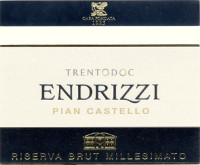
|
|
Trento Brut Riserva Pian Castello 2010 |
|
| Endrizzi (Trentino, Italy) | |
 Chardonnay (60%), Pinot Nero (40%) Chardonnay (60%), Pinot Nero (40%) | |
| Price: € 16.90 | Score: |
 Brilliant straw yellow and nuances of greenish yellow, very
transparent, fine and persistent perlage. Brilliant straw yellow and nuances of greenish yellow, very
transparent, fine and persistent perlage.
 Intense, clean, pleasing, refined and elegant, starts with hints of
apple, banana and hazelnut followed by aromas of pear, hawthorn, flint,
bread crust, plum, yeast, citrus fruits, honey and hints of vanilla. Intense, clean, pleasing, refined and elegant, starts with hints of
apple, banana and hazelnut followed by aromas of pear, hawthorn, flint,
bread crust, plum, yeast, citrus fruits, honey and hints of vanilla.
 Effervescent and crisp attack, however balanced by alcohol, good body,
intense flavors, pleasing roundness. Effervescent and crisp attack, however balanced by alcohol, good body,
intense flavors, pleasing roundness.
 Persistent finish with flavors of apple, banana and pear. Persistent finish with flavors of apple, banana and pear. Refermentation in bottle and aged on its lees for about 5 years. Refermentation in bottle and aged on its lees for about 5 years. |
|
 Pasta with fish, Broiled crustaceans, Roasted fish, Roasted white meat Pasta with fish, Broiled crustaceans, Roasted fish, Roasted white meat |
|
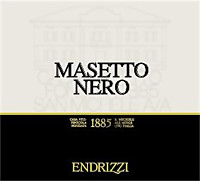
|
|
Gran Masetto 2011 |
|
| Endrizzi (Trentino, Italy) | |
 Teroldego Teroldego | |
| Price: € 39.00 | Score: |
 Deep ruby red and nuances of ruby red, impenetrable to light. Deep ruby red and nuances of ruby red, impenetrable to light. Intense, clean, pleasing, refined and elegant, starts with hints of
plum, blackberry and black cherry followed by aromas of violet, blueberry,
vanilla, pink pepper, tobacco, chocolate, cinnamon, mace and menthol. Intense, clean, pleasing, refined and elegant, starts with hints of
plum, blackberry and black cherry followed by aromas of violet, blueberry,
vanilla, pink pepper, tobacco, chocolate, cinnamon, mace and menthol.
 Tannic attack and however balanced by alcohol, full body, intense
flavors, pleasing roundness. Tannic attack and however balanced by alcohol, full body, intense
flavors, pleasing roundness.
 Very persistent finish with long flavors of plum, blackberry and black
cherry. Very persistent finish with long flavors of plum, blackberry and black
cherry.
 20 months in barrique, 6 months in bottle. 20 months in barrique, 6 months in bottle. |
|
 Game, Roasted meat, Stewed and braised meat, Hard cheese Game, Roasted meat, Stewed and braised meat, Hard cheese |
|
News |
|
In this section are published news and information about events concerning the world of wine and food. Whoever is interested in publishing this kind of information can send us a mail to our address.
|
AquavitaeReview of Grappa, Distillates and Brandy |
|
|
| Distillates are rated according to DiWineTaste's evaluation method. Please see score legend in the "Wines of the Month" section. |
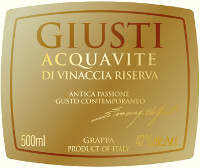
|
|
Acquavite di Vinaccia Riserva 2007 |
|
| Giusti Dal Col (Veneto, Italy) | |
| (Distiller: Distilleria Centopercento) | |
 Blend of grappas from different vintages Blend of grappas from different vintages | |
| Price: € 60.00 - 50cl | Score: |
 Intense amber yellow color, limpid and crystalline. Intense amber yellow color, limpid and crystalline. Intense, clean, pleasing, refined and elegant with aromas of prune,
vanilla, dried fig, caramel, dried violet, tobacco, honey, hazelnut,
licorice and chocolate with almost imperceptible alcohol pungency. Intense, clean, pleasing, refined and elegant with aromas of prune,
vanilla, dried fig, caramel, dried violet, tobacco, honey, hazelnut,
licorice and chocolate with almost imperceptible alcohol pungency.
 Intense flavors with perceptible alcohol pungency which tends to
dissolve rapidly, pleasing roundness, balanced sweetness. Intense flavors with perceptible alcohol pungency which tends to
dissolve rapidly, pleasing roundness, balanced sweetness.
 Persistent finish with flavors of prune, hazelnut, honey and caramel. Persistent finish with flavors of prune, hazelnut, honey and caramel. Blend of grappas from different vintages and aged for 6 years in
barrique. Blend of grappas from different vintages and aged for 6 years in
barrique.
|
|
Wine Parade |
|
|
| The best 15 wines according to DiWineTaste's readers. To express your best three wines send us an E-mail or fill in the form available at our WEB site. |
| Rank | Wine, Producer | |
|---|---|---|
| 1 |
| Verdicchio dei Castelli di Jesi Classico Superiore Podium 2010, Garofoli |
| 2 |
| Brunello di Montalcino Vigneto Manachiara 2007, Tenute Silvio Nardi |
| 3 |
| Offida Rosso Il Grifone 2008, Tenuta Cocci Grifoni |
| 4 |
| Trento Extra Brut Riserva Lunelli 2006, Ferrari |
| 5 |
| Adarmando 2011, Tabarrini |
| 6 |
| Brunello di Montalcino Montosoli 2009, Altesino |
| 7 |
| I Sodi di San Niccolò 2008, Castellare di Castellina |
| 8 |
| Camartina 2011, Querciabella |
| 9 |
| Montiano 2011, Falesco |
| 10 |
| Trento Extra Brut Perlé Nero 2007, Ferrari |
| 11 |
| Avvoltore 2011, Moris Farms |
| 12 |
| Torgiano Rosso Riserva Rubesco Vigna Monticchio 2007, Lungarotti |
| 13 |
| Sagrantino di Montefalco Collepiano 2007, Arnaldo Caprai |
| 14 |
| Amarone della Valpolicella 2009, Fattori |
| 15 |
| Brunello di Montalcino Riserva Poggio alle Mura 2009, Castello Banfi |
| |||||||
Privacy Policy | |||||||


| Copyright © 2002-2024 Antonello Biancalana, DiWineTaste - All rights reserved |
| All rights reserved under international copyright conventions. No part of this publication and of this WEB site may be
reproduced or utilized in any form or by any means, electronic or mechanical, without permission in writing from DiWineTaste. |